


At the recent All Things Digital conference, Steve Jobs and Bill Gates talked about the past 30 years of computing, Palm rolled out more proof that the company is headed nowhere, and Microsoft CEO Steve Ballmer demonstrated a multitouch table called Surface.
Onlookers praised the friendly banter between Jobs and Gates, panned the Palm mini-laptop as boorish, but didn't quite know what to make of Surface. What is Surface, and why is it from Microsoft?
Prepare for Dive!
At first glance, Surface appears to be a magical light table that reacts to users' touch, sensing even multiple inputs at once, as well as identifying items placed on the surface.
From Ballmer's demonstration, it appears to magically pull data from devices--including digital cameras--and recognize bottles of wine. Microsoft's press releases say that Surface has been under secret development at Microsoft for over a half decade.
This is all tremendously out of character for the company, which has--so far--only sought out ways to reshape the existing Windows PC to dominate new product categories. Has Microsoft morphed into a larger, richer version of Apple, Inc.? Is Microsoft finally shifting from a marketing company to an engineering company?
What's up with Surface, and when has the company released ground breaking new products before?
Something Suspicious Under the Surface.
Having chronicled Microsoft's technology introductions since 2000, I can't help but feel like the sudden release of a new product with such a magical aura is simply suspicious.
In each of the last seven years of the 2000s, Gates has presented his company's vision for the future to increasingly bored crowds at the Las Vegas Consumer Electronics Show. This last year, the entire CES show was simply blown away by the parallel Macworld Expo in San Francisco, where Jobs unveiled the iPhone.
At previous CES shows, Microsoft has dutifully rolled out iterations of product visions that nearly all either ended up as huge failures or never even made it to market:
-
•2000 Web TV (dead), Microsoft TV (what's that?), WinCE smartphones previewed two years early
-
•2001 Xbox (billions of dollars in losses), Ultimate TV (gone), "Windows Powered" (more WinCE rebranding)
-
•2002 Mira (stillborn), Freestyle (the code name for Media Center)
-
•2003 Media Center PC, Tablet PCs, SPOT watches, Media2Go (the iPod Killer; four losers in total)
-
•2004 Media Center again, Media2Go re-announced as Portable Media Center (dead)
-
•2005 Digital Entertainment Anywhere ramblings
-
•2006 Xbox 360 (stuffed into the channel), more Portable Media Center (later sacrificed for the Zune)
-
•2007 Vista (cooly received, rejected by Dell), Windows Home Server (still in progress)
With that line up of dead-end “innovation” from one of the largest tech companies on the planet, one is left to wonder: why is Microsoft suddenly and uncharacteristically playing up a secret product, purportedly older than the Xbox and Longhorn?
Secrets from Microsoft?
Microsoft has no secrets; its product introductions are quite predictable. Repackage “Windows” in a new form factor (a Newton, watch, a display, a PlayStation, a Tivo, a tablet, Palm Pilot, etc), announce it as the second coming, then fruitlessly pound money into the project in vain attempts to animate it.
Microsoft been performing increasingly violent CPR on WinCE, hemorrhaging billions on the Xbox, and ineffectually squirting adrenaline into the corpse of the Windows Media/Media Center/Portable/Janus DRM for years. No surprises here. Even the “new” Zune was just a rebadged Toshiba Portable Media Center brick.
The only products Microsoft actually sells at a profit are those that involve no choice or real alternatives on the part of consumers: Windows and Office on the PC. It managed to crank out an update to Windows XP in that same six years, an update that even the staunchest supporters of Microsoft have squawked about in complaint.
A Pattern Emerges.
Run the clock back another decade, and time reveals that Microsoft has an unbroken record of floating an idea, blowing cash at it, renaming it repeatedly to fit it into the most recent marketing push, then leaving it to rot.
That’s what the company did with its strategy for anti-QuickTime, the series of rivals that all went nowhere in random directions: Video for Windows, ActiveMovie, ChromEffects, DirectMovie, Advanced Streaming Format.
Unlike Apple, Microsoft has exposed its roadmaps far into the future. Commonly, that road forks and dead ends, and every two years the road stretches out another two years with the same outlook.
In 1991, the main road was Cairo, which stretched out into 1997 before vanishing; in 2001 the road was Longhorn, which stopped and restarted several times before ending up as Vista in 2007, which was just a release of XP with a bolted on layer of Mac OS X technologies.
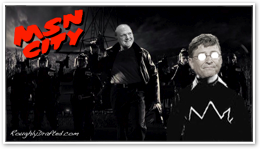 This is not a company that pulls out ‘one more thing’ and excites crowds with dramatic unveilings of products that are available in two weeks. That's the pageantry of Steve Jobs' Apple, a strategy which relies upon legendary secrecy to create such giddy anticipation.
This is not a company that pulls out ‘one more thing’ and excites crowds with dramatic unveilings of products that are available in two weeks. That's the pageantry of Steve Jobs' Apple, a strategy which relies upon legendary secrecy to create such giddy anticipation. iPhone vs Surface.
After a year of bated anticipation about an Apple mobile phone, Jobs pulled out the iPhone and delighted the company's fans with a magically thin new mobile phone with the built-in capacity to run a desktop operating system; sensors that detect proximity, ambient light, and how its being held; a multitouch screen without a stylus; a rich, solid user interface; and most importantly, the sophisticated software that drives it all.
Jobs said Apple had been working on the iPhone for two and a half years. In other words, Apple had started work on the iPhone around the middle of 2004. Much of the work was done in parallel with other Apple products.
It shares a lot of technology with the Mac: the frameworks of OS X, the core engine of Apple's Mail and the Safari web browser, and the sophisticated animation and graphics libraries that deliver its interface. It also shares some manufacturing technology with the iPod; it certainly benefits from Apple's experience in building ten different form factors of iPods, all of which have been major successes.
Now compare Surface. Microsoft says it's been working on it since 2001; that's six years of development. With what result? It's not small like the iPhone. It doesn't have a specific user interface. It appears to be built out of spare parts from Ikea. Why was Surface in development so long, and what does it really offer?
Peering Beneath the Surface.
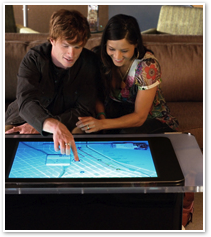 In reality, Surface isn't a giant touch screen system. It's a frosted acrylic light table. Like everything else Microsoft has pushed out, its also a Windows PC. There's no touch screen involved at all.
In reality, Surface isn't a giant touch screen system. It's a frosted acrylic light table. Like everything else Microsoft has pushed out, its also a Windows PC. There's no touch screen involved at all. Instead, the system uses a series of five video cameras hidden inside the bathtub base. The PC it uses, like most PCs, has support for yesteryear's 802.11g wireless networking and Bluetooth, as well as the ho-hum 10/100 Ethernet I criticized Apple for using in the new AirPort Extreme and in Apple TV. At least they both offer wireless-n.
Clearly, Microsoft should have started with a Mac inside the Surface, as it would get support for wireless-n and Gigabit Ethernet at no extra cost!
Since the box costs $5,000 to $10,000, certainly Ballmer could afford using a Mac. It’s also too hard to resist the Ballmerism, “$10,000 for a PC table? That's the most expensive PC on the planet! And it doesn't appeal to business customers because it doesn't have a keyboard!”
So wait, we have an Ikea tub, a boorish Windows PC, and a bunch of cameras. Where is the product, the innovation, and the solution here? Is this just a huge scam to generate some sort of suggestion that Microsoft is the new Apple?
Cutting Through the Crap.
What's going on when a WiFi enabled digital camera is placed on the magical Surface? It's not magical, it's wireless syncing, which has nothing to do with a piece of frosted plastic. All Surface does is display your photos after they've synced.
It gets worse. How does Surface magically identify items placed on it? By scanning barcodes affixed to them. Microsoft uses a special dotted code tag it calls a domino, with room for 8 dots of data. Reminiscent of 8.3 DOS filenames, that will give the Surface the ability to distinguish a whopping 32 256 different tags! Brilliant.
Want your own Surface? Get Wil Shiply's Delicious Library, and use the Mac Book's built in iSight camera to interact with with a ‘Surface’ that isn't there: no two foot deep plastic box, no $10,000 price tag, and considerably more range in the number of different barcodes you can distinguish between.
Surface is simply the biggest line of crap Microsoft has pulled off, perhaps ever. It is a loose assembly of cameras in a big box acting as a bar code scanner, Sony's EyeToy in a huge form factor. But wait, isn't innovation about taking existing technologies and putting them together in new ways to solve new problems?
The real problem for Surface is that it does nothing new. Lots of companies already offer touch tables that allow multiple users to manipulate images, navigate through maps and renderings, and project fancy interfaces for visualizing data.
Commonly, such high-end projector scanner systems are custom built for the client. What's is Microsoft's value add with Surface? Is it ready to go? Miniaturized? Higher quality? Cheap?
The Engineering Triangle.
Engineering is not just brainstorming; it is the science of tradeoffs. Engineers start with a triangle of options: expense, time, and quality, and either work to create a perfectly balanced triangle or a custom designed one that fits a particular need. There are tradeoffs in both an engineering project and in an engineered product.
The iPhone as an engineering project has spent a total of about three years in development, at considerable expense, to create a high quality product. The iPhone as an engineered product targets an iPod-like price point and a high quality user experience, but Apple spent a long time developing it.
In order to add features, more time and money would be involved. Apple decided to set specific goals for the unit and focus it primarily as a phone for making calls. You can't run SNES games on it, it can't video conference, and it doesn't make you lose weight. Adding those features would adjust the shape of the iPhone's time, cost, and quality triangle, making it cost more, delaying its release, and complicating its simplicity.
Breaking the Surface Tension.
Now look at the Surface. It's been in development for 6 years, and still isn't ready. It has a nebulous price that is in the range of fanciful, and there is nothing clear or obvious about its quality. What does it do exactly?
In reality, it's a custom platform that clients will have to build themselves. This isn't a finished product at all, but a Tinker Toy set for creating an interactive kiosk. It’s a committee brainstorm wrapped up in layers of marketing.
Every Surface customer will be paying, not just $10,000 for a bathtub of cameras and a PC, but lots more money for a custom integrated solution built upon Microsoft's fledgeling Windows Presentation Foundation in Vista.
Surface is another public beta program for Vista; it just costs ten grand to get started. The most shocking element of the Surface is that, while it allows Microsoft to take credit for things others have already done, it demonstrates no brilliant engineering on the part of its maker.
Where’s the Beef?
Why use an assortment of unwieldy, large video cameras? That’s certainly not cost effective nor sensible for a product Microsoft suggests will someday be in everyone’s home. There simply is no tough engineering choices here, it’s all marketing surrounding some fanciful user interface demos that belong in Minority Report.
We saw the same impractical demonstrations with Mira, SPOT, WinCE, Portable Media Centers, etc. Surface is no secret, avant-garde engineering product, it’s simple marketing fluff that scrapes together a bunch of ideas already delivered elsewhere, gives it a fancy product name, and does so without much regard for practicality.
According to Microsoft’s website, “Surface is the first commercially available surface computer from Microsoft Corp.” Wow. A history timeline purports to take all credit for animation and touch control, arming Paul Thurrott with the historical revisionism necessary to credit everything delivered in the iPhone to his Chief Architect deity.
Steve Ballmer: The Naked Emperor of Maker Faire.
At last month's Maker Faire, homebrew robot makers were showing off a rear projection lucite table that similarly responded to finger touches from multiple users. I stuck my hands on it. Did they spend six years inside of a Microsoft bunker to whip together that free demonstration? No, they built it in their garage from spare parts.
Certainly Microsoft, which attended the Maker Faire as an major exhibitor, was aware that “the Surface” was being demonstrated next door. Microsoft was busy trying to generate excitement for its Windows Home Server, announced in January at CES. The company was handing out little first-aid kits containing band-aids, alcohol wipes, and two Tylenol with the marketing line: “stop digital amnesia in its tracks with Windows Home Server.”
How clever! “Hey homebrew Makers, here's a prebuilt PC that backs up your data! Bet you never thought of that. Oh, what’s that display touch table you have? Please hide it, we're about to release the same thing as a top secret project we’ve been laboring on for the better part of the decade, and you're making us look like fools!”
The second joke, of course, is the idea that amnesia would somehow be solved by band-aids and Tylenol.
Steampunk tinkerers aren't the only ones to demonstrate an interactive light table. At last years' Maker Faire, another company demonstrated an interactive table that displayed a fully interactive interface for Google Maps, controlled by tilting the table. 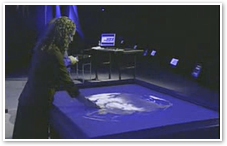

And back in 2005, TouchTable demonstrated a fully functional product with a cohesive user interface that actually is a touch table, not an assembly of cameras in a box. Ray Meyers of RipRagged sent a link to the video:
Prior Art? Pfft!
Never mind that people have been building functional multi-touch tables for years, or that other companies have similarly been selling them commercially. It’s top form for Microsoft to enter an established space, reserve a simple noun for itself as a trademark, and then pretend to own the legacy it tramples upon.
Gates may be ashamed about the exposure of his Windows legacy being mostly a fraud, and by his company’s panicked inability to make any headway into consumer electronics. But trying to claim credit for the interactive, touch-driven interfaces of the future by floating a generalized concept in 2007 is too much to swallow.
Microsoft has neither introduced anything revolutionary, nor improved upon existing technologies, nor found a clear and obvious application for multitouch the way Apple has with the iPhone. What it has done is ported the general idea to Windows, desperately associated Surface hype with the Zune (which has non-functional WiFi) and retroactively claimed credit for a wide swath of technologies dating back to 2001. Wow, that’s crap.
That tends to overshadow the innovative software ideas Surface appears to introduce: visualized controls that enable users to toss pictures toward a phone to copy them, or a Dock like interface that launches cocktails rather than Mac applications. This is the kind of flourish Adobe wants to deliver with Flash, not rocket science.
Björk’s Reactable, developed at the Pompeu Fabra University in Barcelona. [Reactable - Google Video]
NYU/Jef Han’s Camera-Free, Multi-Touch Sensing, 2005 [FTIR Touch Sensing] [Jef Han at TED - YouTube]
Enter the Analysts!
The last two articles reflected on how quick some analysts are to pounce upon every product from Apple and insist that it won't matter, is overpriced, won't sell, and offers nothing new. Will they express the same candor and dissatisfaction about Microsoft's new product vision, the smoke blowing, credit-grabbing Surface?
What do you think? Send me your best Surface gushing blowhards.
I already have Mike Elgan's reverent worship of the Surface from Computerworld, and the next article will examine the remains of his credibility.
Like reading RoughlyDrafted? Share articles with your friends, link from your blog, and subscribe to my podcast!
Did I miss any details?
Next Articles:
This Series

Haloscan Q107
Scratching the Surface of Microsoft's New Table PC
Monday, June 4, 2007

Ad



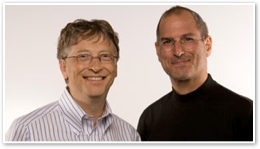


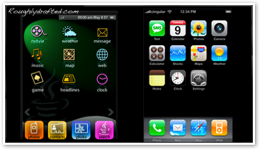




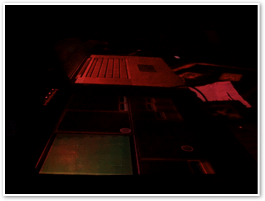

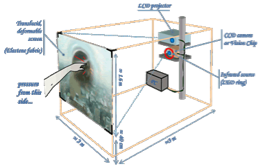
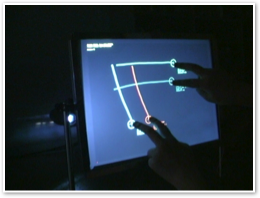
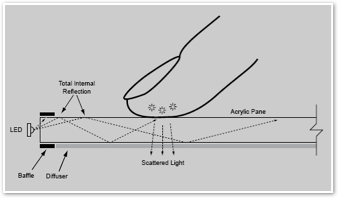


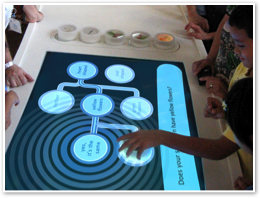
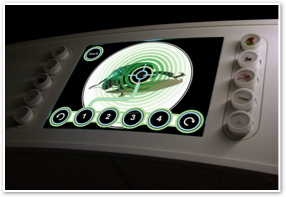

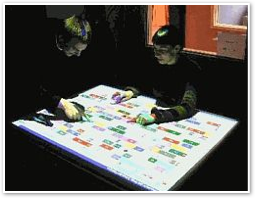
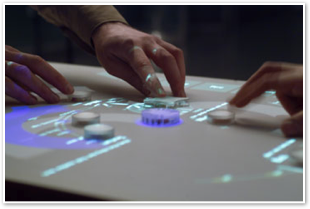



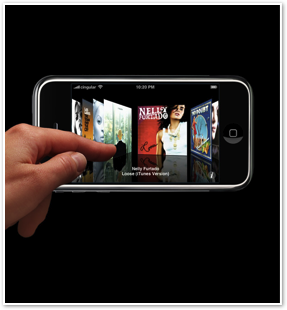



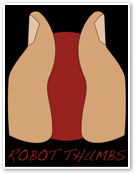
 Bookmark on Del.icio.us
Bookmark on Del.icio.us Discuss on Reddit
Discuss on Reddit Critically review on NewsTrust
Critically review on NewsTrust Forward to Friends
Forward to Friends
 Get RSS Feed
Get RSS Feed Download RSS Widget
Download RSS Widget





